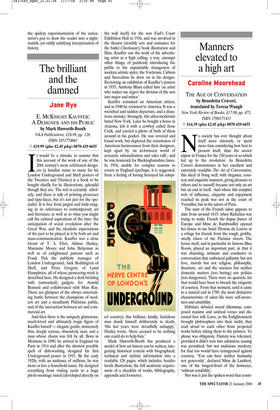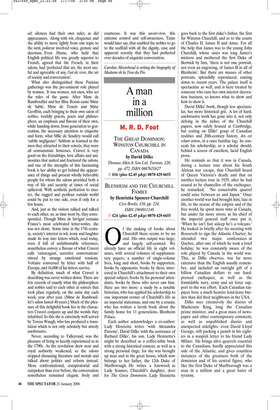Manners elevated to a high art
Caroline Moorehead
THE AGE OF CONVERSATION by Benedetta Craveri, translated by Teresa Waugh New York Review of Books, £17.99, pp. 475, ISBN 1590171411 ✆ £14.39 (plus £2.45 p&p) 0870 429 6655 No society has ever thought about itself more intensely, or spent more time considering how best to present itself, than the ancien régime in France for the 150 years or so which led up to the revolution. As Benedetta Craveri demonstrates in her excellent and extremely readable The Art of Conversation, this ideal of living well, with elegance, courtesy and exquisite manners, giving pleasure to others and to oneself, became not only an art but an end in itself. And where this complex web of influence, etiquette and enjoyment reached its peak was not at the court of Versailles, but in the salons of Paris.
The start of the French salon appears to date from around 1615, when Richelieu was trying to make French the lingua franca of Europe and Mme de Rambouillet opened her house in rue Saint-Thomas du Louvre as a refuge for friends from the rough, grubby, smelly chaos of the Parisian streets. The house itself, and in particular its famous Blue Room, played an important part, in that it was charming, intimate and conducive to conversation that embraced gallantry but not love, morals but not religion, philosophy, literature, art and the sciences but neither domestic matters (too boring) nor politics (too dangerous). There were no quarrels, for that would have been to breach the etiquette of courtesy. From that moment, until it came to a natural end in 1789, the most distinctive characteristics of salon life were self-awareness and amiability.
Habitués debated moral dilemmas, composed maxims and satirical verses and discussed free will. Later, as the Enlightenment brought philosophers into their midst, they read aloud to each other from projected works before taking them to the printers. To please was obligatory. Flattery was tolerated, provided it didn’t turn into adulation; teasing was permitted, but not malicious mockery, for that too would have transgressed against courtesy. ‘You can have neither humanity nor generosity’, declared Mme de Lambert, one of the longest-lived of the hostesses, ‘without sensibility’.
Nor was it just the spoken word that count ed: silences had their own rules, as did appearances. Along with wit, eloquence and the ability to move lightly from one topic to the next, politesse involved voice, gesture and decorum. Even Hume, who held that English political life was greatly superior to French, agreed that the French, in their salons, had ‘perfected that art, the most useful and agreeable of any, l’art de vivre, the art of society and conversation’.
What also distinguished these Parisian gatherings was the pre-eminent role played by women. It was women, not men, who set the rules of the game. After Mme de Rambouillet and her Blue Room came Mme de Sablé, Mme de Tencin and Mme Geoffrin, each bringing to their own salon of nobles, worldly priests, poets and philosophers, an emphasis and flavour of their own, while handing down, from generation to generation, the necessary attention to etiquette and form, what Mlle de Scudéry would call ‘subtle negligence’. Seldom as learned as the men they attracted to their soireés, they were all consummate hostesses. Craveri is very good on the friendships, love affairs and animosities that united and fractured the salons, and one of the strengths of this fascinating book is her ability to get behind the appearance of things and present wholly believable people for whom the salons provided both a way of life and security at times of social upheaval. With aesthetic perfection to master, the rugged and perilous outside world could be put to one side, even if only for a few hours.
And, just as the visitors talked and talked to each other, so, as time went by, they corresponded. Though Mme de Sévigné remains France’s most celebrated letter-writer, she was not alone. Some time in the 17th century, society’s interest in wit, irony and laughter made its way into letters which, read today, even if full of unfathomable references, nonetheless convey a flavour of what Craveri calls ‘extravagant, secretive conversations’ stirred by strange emotional tensions. Voltaire conversed by letter with half of Europe, and 16,000 of his letters survive.
By definition, much of what Craveri is describing was never written down. There are few records of exactly what the philosophers and nobles said to each other at soireés that took place regularly, on the same day each week, year after year. (Mme de Rambouillet’s salon lasted 40 years.) Much of the pleasure of this delightful book lies in the characters Craveri conjures up and the worlds they inhabited. In this she is extremely well served by Teresa Waugh, who has produced a translation which is not only scholarly but utterly unobtrusive.
Never, according to Talleyrand, was the pleasure of living so keenly experienced as in the 1780s. As the revolution drew near and royal authority weakened, so the salons stopped discussing literature and morals and talked about politics and reform instead. More confrontational, conspiratorial and outspoken than ever before, the conversation nonetheless remained elegant, lively and courteous. It was this savoir-vivre, this extreme control and self-awareness, Taine would later say, that enabled the nobles to go to the scaffold with all the dignity, ease and apparent serenity that they had perfected over decades of exquisite conversation.




















































 Previous page
Previous page